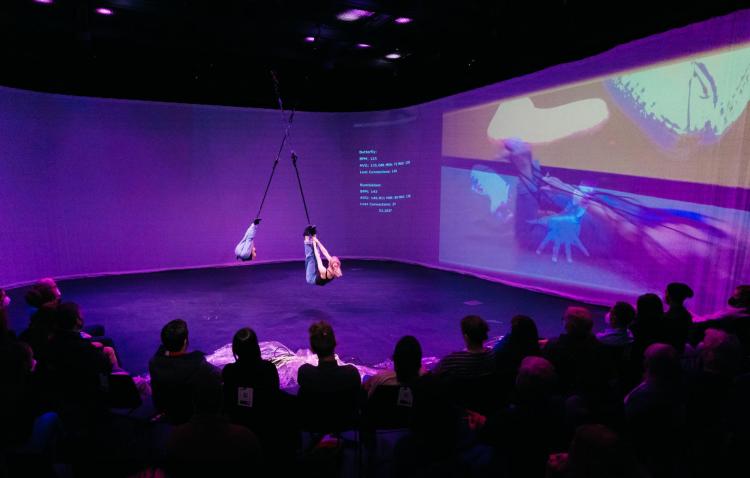Soaring heart rates: Revealing a performer’s inner world
She’s a trapeze artist. He’s a computer scientist. Together, they’re hoping to redefine immersive performance.
Anna Pillot, a master’s student in the Department of Theatre and Dance, was on a run in Boulder when her fitness watch alerted her to a spike in her heart rate.
She adjusted her pace.
Slowed her breathing.


Dance MFA candidates Anna Pillot and Caroline Butcher performing at the ATLAS B2 Blackbox Experimental Studio. (Credit: Elliot Whitehead)
Through the tiny screen on her wrist, she watched as her heart rate slowly recovered.
Her experience sparked an idea: What if she could use the same technology in her watch to show an audience what was happening within her body during a performance?
This was the inspiration behind Pillot’s latest show at the ATLAS B2 Blackbox Experimental Studio.
“IMbalance | INbalance,” which ran Feb. 25–26, blended aerial dance and computational creativity to reveal the inner workings of a dancer in motion.
Using the same biometric sensors in fitness watches combined with a state-of-the-art 3D motion capture system, the performance synchronized the dancer's heart rate with sound, lighting and video projections, allowing the audience to share in the experience.
“If it's going to feel truly immersive, then there shouldn't be a separation of performer and observer,” Pillot said. “We wanted to build an instantaneous connection, where the audience was in the performance with us.”
Pillot, who trained as a trapeze artist with some of the world’s top circus producers before coming to CU Boulder in 2020, partnered with fellow Dance MFA candidate Caroline Butcher to create and perform the choreography.
As they danced, their heart rates were projected onto the backdrop in beats per minute (BPM). They coordinated with each other verbally and physically throughout the show, performing various tricks and sequences with the goal of controlling and synchronizing their heart rates.
“When you externalize the internal, it creates this sort of feedback loop,” Pillot said. “How we’re interacting with each other on stage affects the audience’s reaction, which in turn affects us as performers.”
At the end of the show, when PIllot and Butcher reached a peak of 170 BPM, they laid on the floor and took deep breaths. The music slowed with their heart rate and the colors faded from fiery reds to cool blues until the theater was silent and the dancer’s were at rest.
Mixing cirque and science
The performance by Pillot and fellow Dance MFA candidate Caroline Butcher is part of the ATLAS B2 Center for Media, Arts & Performance—an interdisciplinary innovation hub that co-mingles art and technology.
That's where Pillot met Brad Gallagher, a doctoral candidate in Intermedia Art, Writing and Performance.
Gallagher worked with a computational astrophysics group at the University of Chicago for 13 years, visualizing datasets to make 3D simulations of star explosions and supernovas.
“During that time, I was very active in making music and always thought of myself as somebody who's interested in art, “ Gallagher said.
Since joining the B2 Center, he’s been experimenting with their state-of-the-art 3D motion capture system—technology that records the movement of people or objects, and converts it into data used to generate a 3D view of the performance. Similar technology is used in Hollywood to create real-life fictional characters, like Gollum in Lord of the Rings or Caesar in Planet of the Apes.
Gallagher’s interest lies in the live performance applications of the system—how a performer’s movement can trigger sound, lighting and video in real time. In teaming up with Pillot, he was able to bring his ideas to the stage.

Pillot's heart rate projected on the backdrop as she rests. (Credit: Elliot Whitehead)
By attaching biometric sensors to the dancer’s bodies, Gallagher will use computation, coding and creativity to completely automate and sync the performance projections.
“I think the technology will really help pull the audience in and immerse them in the show,” Gallagher said. “But I think what's even going to be more effective is the performance that Anna and Caroline are going to bring to this, and seeing how their presence as human bodies can make the audience sympathize even more.”
After this weekend’s performance, Gallagher plans to continue this research by exploring the implications of artificial intelligence in live performance.
“I think we're headed towards a place where performing a particular art piece could create additional art,” he said.
Specifically, he’s hoping to investigate ways to reverse causality between music and dance.
“Right now we have music dictating the choreography of a performance, but imagine a world where the dancer’s movement could create the musical score in real time.”
"IMbalance|INbalance" is made possible by the Arts and Cultural Enrichment Grant, Graduate Research in Dance Fund, and MFA Excellence in Research Micro Grant.
You can register here for free tickets to this weekend’s performance.


